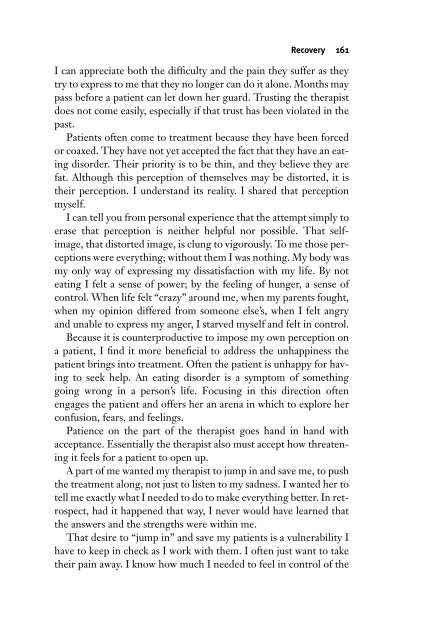Eating Disorders - fieldi
Eating Disorders - fieldi
Eating Disorders - fieldi
You also want an ePaper? Increase the reach of your titles
YUMPU automatically turns print PDFs into web optimized ePapers that Google loves.
Recovery 161<br />
I can appreciate both the difficulty and the pain they suffer as they<br />
try to express to me that they no longer can do it alone. Months may<br />
pass before a patient can let down her guard. Trusting the therapist<br />
does not come easily, especially if that trust has been violated in the<br />
past.<br />
Patients often come to treatment because they have been forced<br />
or coaxed. They have not yet accepted the fact that they have an eating<br />
disorder. Their priority is to be thin, and they believe they are<br />
fat. Although this perception of themselves may be distorted, it is<br />
their perception. I understand its reality. I shared that perception<br />
myself.<br />
I can tell you from personal experience that the attempt simply to<br />
erase that perception is neither helpful nor possible. That selfimage,<br />
that distorted image, is clung to vigorously. To me those perceptions<br />
were everything; without them I was nothing. My body was<br />
my only way of expressing my dissatisfaction with my life. By not<br />
eating I felt a sense of power; by the feeling of hunger, a sense of<br />
control. When life felt “crazy” around me, when my parents fought,<br />
when my opinion differed from someone else’s, when I felt angry<br />
and unable to express my anger, I starved myself and felt in control.<br />
Because it is counterproductive to impose my own perception on<br />
a patient, I find it more beneficial to address the unhappiness the<br />
patient brings into treatment. Often the patient is unhappy for having<br />
to seek help. An eating disorder is a symptom of something<br />
going wrong in a person’s life. Focusing in this direction often<br />
engages the patient and offers her an arena in which to explore her<br />
confusion, fears, and feelings.<br />
Patience on the part of the therapist goes hand in hand with<br />
acceptance. Essentially the therapist also must accept how threatening<br />
it feels for a patient to open up.<br />
A part of me wanted my therapist to jump in and save me, to push<br />
the treatment along, not just to listen to my sadness. I wanted her to<br />
tell me exactly what I needed to do to make everything better. In retrospect,<br />
had it happened that way, I never would have learned that<br />
the answers and the strengths were within me.<br />
That desire to “jump in” and save my patients is a vulnerability I<br />
have to keep in check as I work with them. I often just want to take<br />
their pain away. I know how much I needed to feel in control of the









